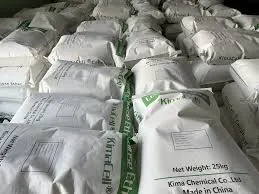
Nov . 30, 2024 20:28 Back to list
hydroxyethyl cellulose sds
Understanding Hydroxyethyl Cellulose and Its Safety Data Sheet (SDS)
Hydroxyethyl cellulose (HEC) is a non-ionic, water-soluble polymer derived from cellulose, a natural polysaccharide found in plants. HEC is synthesized through the etherification of cellulose with ethylene oxide, resulting in a versatile compound that exhibits a range of beneficial properties. Due to these properties, it is used extensively in various industries, including pharmaceuticals, food, cosmetics, and construction.
Chemical Properties and Applications
HEC is characterized by its ability to form viscous solutions, which makes it an excellent thickening agent. Its water solubility allows it to be easily integrated into various formulations without affecting other components. HEC is widely used in the formulation of cosmetics and personal care products as a thickener and stabilizing agent. In pharmaceuticals, it is used as a vehicle for drug delivery, enhancing the viscosity and stability of topical formulations.
In the food industry, HEC functions as a food additive, primarily serving as a thickening agent and stabilizer. It is considered safe for consumption, being classified as GRAS (Generally Recognized as Safe) by the FDA when used appropriately. In construction, HEC is incorporated into cementitious materials to improve workability and prevent segregation.
Safety Data Sheet (SDS) Overview
For any chemical substance, a Safety Data Sheet (SDS) is a crucial document that provides detailed information on the properties, handling, and potential hazards associated with that substance. The SDS for hydroxyethyl cellulose outlines several important sections
1. Identification This section includes the chemical name, synonyms, and the appropriate uses of HEC. It also provides emergency contact information.
2. Hazard Identification HEC is generally considered non-hazardous. It may cause mild irritation if it comes into contact with eyes or skin, but significant health risks are not commonly associated with the substance under normal handling conditions.
hydroxyethyl cellulose sds

3. Composition/Information on Ingredients The SDS lists the chemical composition of HEC, detailing its molecular structure and the percentage of active polymer in formulations.
4. First-Aid Measures This section outlines appropriate first-aid procedures in case of exposure. For instance, in the event of skin contact, it is recommended to wash the affected area with soap and water. In case of eye contact, flushing the eyes with water for several minutes is advised.
5. Firefighting Measures HEC is combustible. The SDS provides guidance on appropriate firefighting measures, recommending the use of water spray, foam, or dry chemical extinguishers in the event of a fire.
6. Accidental Release Measures In case of spills, the SDS recommends containment and cleanup procedures to minimize environmental impact, emphasizing the importance of using personal protective equipment (PPE) during the process.
7. Exposure Controls/Personal Protection Although HEC is not considered highly hazardous, the SDS suggests using gloves and protective eyewear to prevent any potential irritation during handling.
8. Toxicological Information This section includes data on the potential health effects of HEC, reaffirming its low toxicity and safety when handled according to guidelines.
Conclusion
Hydroxyethyl cellulose is a versatile and valuable compound utilized across numerous industries for its thickening, stabilizing, and emulsifying properties. Understanding its safety through the Safety Data Sheet is essential for safe handling and use. While HEC poses minimal risks, proper precautions should always be taken to ensure a safe working environment. As industries continue to innovate and adapt, hydroxyethyl cellulose remains a staple ingredient contributing to advancements in product formulation and quality.
-
Versatile Hpmc Uses in Different Industries
NewsJun.19,2025
-
Redispersible Powder's Role in Enhancing Durability of Construction Products
NewsJun.19,2025
-
Hydroxyethyl Cellulose Applications Driving Green Industrial Processes
NewsJun.19,2025
-
Exploring Different Redispersible Polymer Powder
NewsJun.19,2025
-
Choosing the Right Mortar Bonding Agent
NewsJun.19,2025
-
Applications and Significance of China Hpmc in Modern Industries
NewsJun.19,2025







